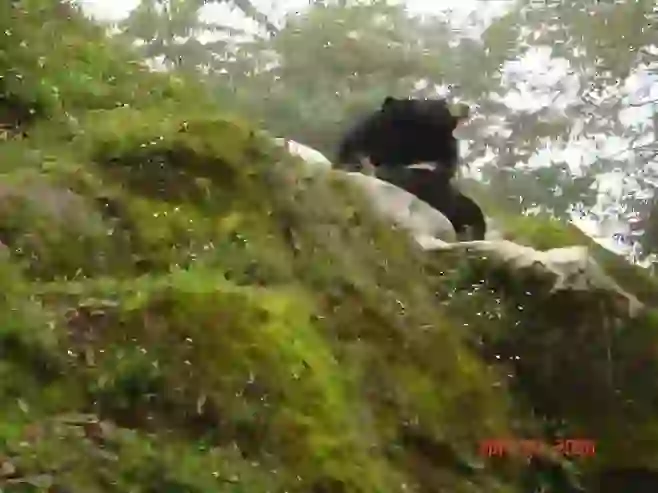
Tibetan Black Bear
Tibetan Black Bear
Tibetan Black Bear
High on the Tibetan Plateau, in one of the highest places on Earth, lives the Tibetan black bear. Adapted to the harsh, cold environment, they are a resilient subspecies of the Asian black bear. Like other subspecies of the Asian black bear, they have a distinctive white, crescent moon-shaped mark on their chest. Let's explore the fascinating ecology of the Tibetan black bear and the world they inhabit.
Tibetan Black Bear Basic Infomation

| Property | Value |
|---|---|
| Scientific Name | Ursus thibetanus thibetanus |
| Taxonomic Status | SUBSPECIES |
| Rank | SPECIES |
| Vernacular Names | Tibetan black bear |
| Kingdom | Animalia |
| Phylum | Chordata |
| Class | Mammalia |
| Order | Carnivora |
| Family | Ursidae |
| Genus | Ursus |
| Habitats | Tibetan Plateau, forests, mountainous areas |
| Conservation Status | Vulnerable (IUCN 2023) |

Size
They are about 5 to 6 feet (1.5 to 1.8 meters) long, and males weigh about 220 to 397 pounds (100 to 180 kilograms). Females are smaller than males.

Lifespan
They live for about 20 to 25 years in the wild.

Distribution
They are found in the Tibetan Plateau and its surrounding areas, including the Himalayas, western China, Nepal, Bhutan, and northeastern India. They live in forests and mountainous areas at elevations of 6,560 to 13,120 feet (2,000 to 4,000 meters).
Tibetan Black Bear Q&A

What kind of bear is the Tibetan black bear?
The Tibetan black bear is a subspecies of the Asian black bear. As its name suggests, it is mainly found in the Tibetan Plateau.
Like other Asian black bears, they have black fur and a white, crescent moon-shaped mark on their chest. They are omnivores and eat plants, fruits, insects, and occasionally small mammals and fish. They are skilled climbers, often seen eating fruit or resting high in trees. They are also known for hibernating during winter, spending the cold months in tree hollows or dens dug in the ground until spring.

What do Tibetan black bears eat?
Tibetan black bears are omnivores, eating a variety of foods, including plants, fruits, insects, and sometimes small mammals and fish.
Their diet varies with the season. In the spring, when they emerge from hibernation, they eat a lot to regain the strength lost during winter. Their diet in this season consists mainly of young leaves, buds, and insects. Summer brings an abundance of fruits and nuts, which become the staples of their diet. In the fall, they eat a lot of acorns and chestnuts to prepare for hibernation, as these are rich in nutrients and ideal for building up fat reserves. They do not eat during hibernation. They also love honey and are known to raid beehives for honey. They may occasionally prey on livestock, which can lead to conflict with humans.

Why do they live in such high altitudes?
There are several possible reasons why Tibetan black bears live in high altitudes.
・Food: There is an abundance of acorns and chestnuts, their preferred food source, in high altitude areas.
・Fewer predators: Large predators, such as tigers and leopards, are less common in high altitudes.
・Temperature: Tibetan black bears are sensitive to heat, making the cooler temperatures of high altitudes more comfortable for them.
They are believed to have adapted to the high-altitude environment and evolved unique traits to survive there.

[Quiz!] Do Tibetan black bears hibernate?
Tibetan black bears do hibernate, but not all individuals do so.
Individuals living in high-altitude regions hibernate, but those living at lower elevations may not. Bears that hibernate typically do so from November to March, spending the winter in tree hollows or rock crevices. During hibernation, they lower their body temperature and heart rate to conserve energy. They also eat a lot and store up fat before hibernation, using these reserves as an energy source during the winter.

[Quiz!] What kind of sounds do Tibetan black bears make?
Tibetan black bears make various sounds, such as 'woof,' 'gya,' and 'boo-boo.'
They make these sounds when they are angry, alert, or calling their cubs. During the breeding season, they may also make a purring sound.

[Quiz!] Are Tibetan black bears endangered?
The Tibetan black bear is listed as 'Vulnerable' on the IUCN (International Union for Conservation of Nature) Red List.
This means they are at high risk of extinction in the near future. Their numbers are declining due to habitat loss, poaching, and human-wildlife conflict. Protecting Tibetan black bears requires protecting their forest habitat, stopping poaching, and preventing human-wildlife conflict.

Would you like to become a part of the 'Animalbook.jp'?
Turn your knowledge into Q&A and share it with the world. ※Publication will be activated after purchase. Let's share information together!
Tibetan Black Bear Type of List

Efforts to Protect Tibetan Black Bears
- Habitat conservation
- Strengthening anti-poaching patrols
- Preventing human-wildlife conflict
- Educating local communities
- Promoting ecotourism
Information
Congratulations! You are the first commenter!

Create Your Favorite List!
Tibetan Black Bear
Save the animals you love! Build your own list to quickly revisit your favorites later.

Would you like to leave a comment?
※Please note: This is for the purchase of rights to post comments within the article.
Find Your Favorites!
Our shop offers a unique and attractive selection of goods themed around various animals.
Tibetan Black Bear References
Tibetan Black Bear Introduction of media used

From Wikimedia Commons, the free media repository

Help Enrich Our Animalbook.jp with Your Media!
We are constantly looking to expand and enrich our Animalbook.jp with amazing photos and videos of animals. If you have any media that you'd like to share, please contribute and help us showcase the beauty and diversity of the animal kingdom. Your submissions will be credited and featured in our encyclopedia, reaching a wide audience of animal lovers.


















